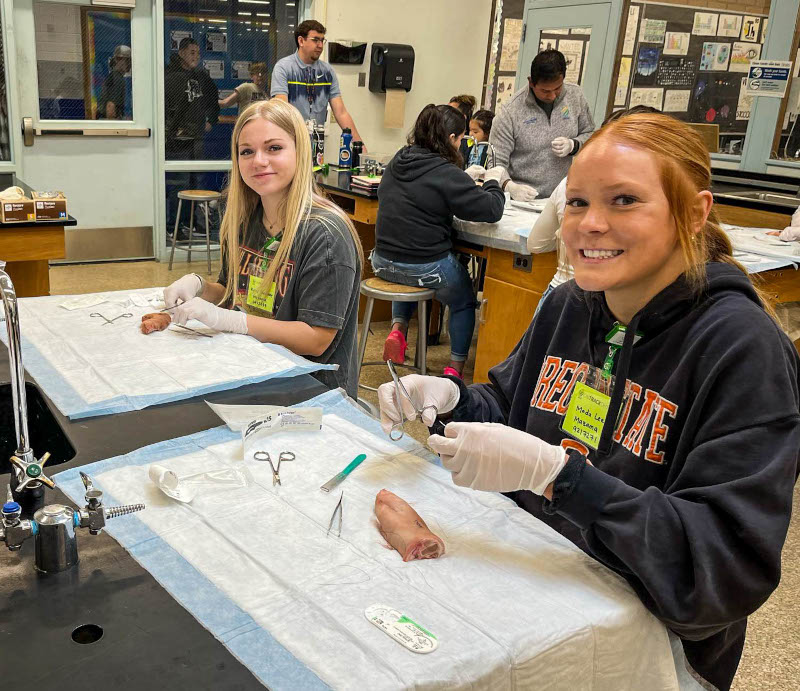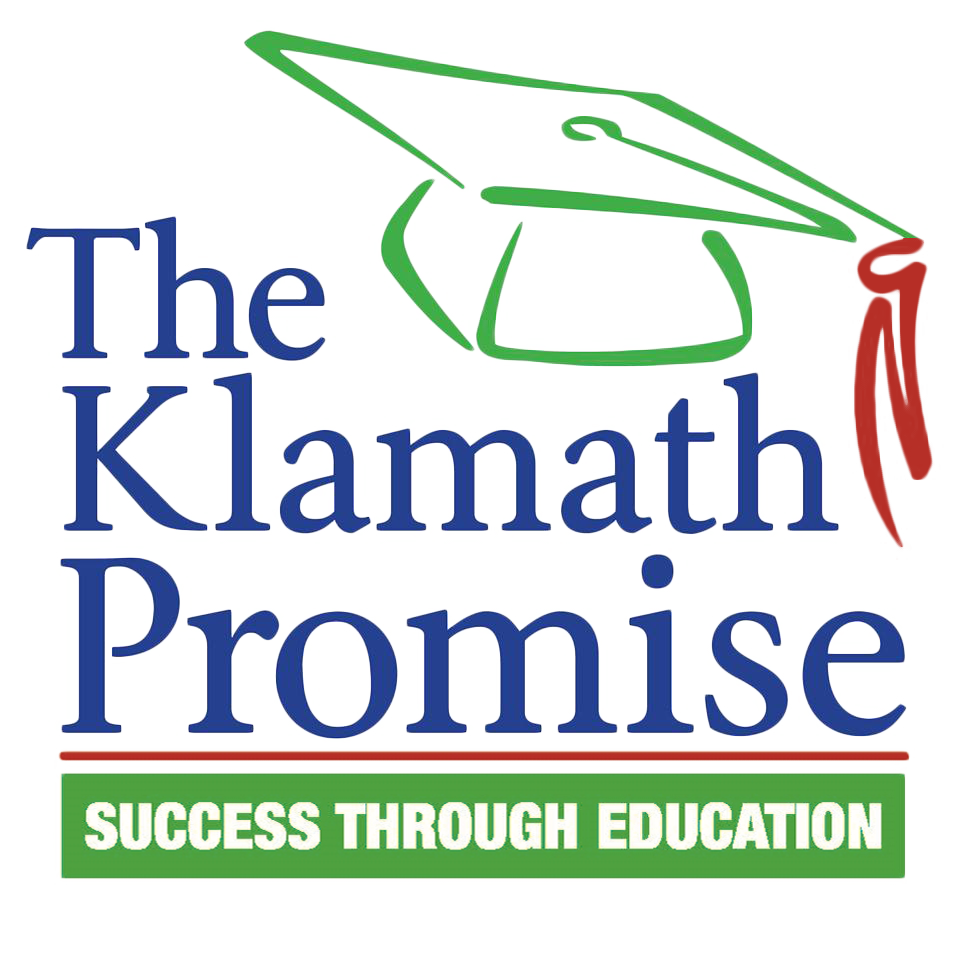Klamath County School District
From Classroom to Community
Career and Technical success for a new economic roadmap
The Klamath County School District covers approximately 6,000 square miles and serves around 7,000 students. The district stretches from central Oregon to the California border and includes two large high schools and four medium-to-small high schools. Gilchrist, the furthest school, is about 100 miles from the central hub.
Glen Szymoniak, Klamath County School District Superintendent, underscores the district’s commitment to community engagement, particularly with the Native American population in Chiloquin, home to the Klamath Tribes. However, the district’s remote location presents challenges in recruiting and retaining staff.
The nearest community, Medford, requires navigating a mountain range or a 140-mile drive to Bend. The isolation necessitates that most of the workforce be locally sourced, considering the sustainability of job positions. The district has decided not to rely on federal ESSER funds for hiring, ensuring stable staffing levels with sustainable state funding. The approach has placed the district in a favorable financial position, particularly compared to other districts facing declining enrollment.
Career and technical education
Henley High School, always proactive in meeting student needs, identified a need for a dedicated Career and Technical Education (CTE) coordinator to support its various programs. Adam Randall, Career and Technical Education Coordinator, a former math teacher with a background in CTE, was hired as a full-time coordinator. The successful initiative, which started as a pilot program, has since expanded to other high schools, ensuring equitable resources and opportunities across the district.
Szymoniak’s tenure, which began in 2018, included implementing a comprehensive strategic planning process involving community stakeholders. The collaborative effort aligned the community’s values and goals with the district’s strategic initiatives. The planning coincided with introducing the Corporate Activity Tax, channeling new funds into education through the Student Success Act and Student Investment Account. The funds provide the district with resources to address needs like enhanced social-emotional support and expanded counseling services.
Data-driven program development
Randall highlights the district’s data-driven approach to building programs and partnerships, aligning efforts with the district’s strategic goals and the Southern Oregon regional needs assessment. This assessment identifies key industries needing workers, including medical science, construction, manufacturing, and education.
The district focuses on these critical areas by analyzing students’ aptitudes and interests through tools like YouScience. The construction program, a standout success, addresses a significant workforce gap. With many tradespeople nearing retirement, there is an urgent need for skilled workers.
The district’s pre-apprenticeship programs, established at Henley, Lost River, Bonanza, and soon at Mazama, are the only ones in Oregon. The programs guarantee graduates direct placement into recognized apprenticeships with the Bureau of Labor and Industries (BOLI), covering trades like carpentry, electrical, plumbing, and drywall. Partnerships with entities like the Southern Oregon Joint Apprenticeship Training Committee (SOJTC) and Klamath Community College have provided the necessary training and curriculum.
The collaboration between the district and Sky Lakes Medical Center exemplifies another successful partnership. Post-COVID, the medical center faced a significant staffing shortage, with 300 vacancies. Sky Lakes and the district establish pathways for students to transition from high school to employment at the hospital.
Programs such as the unit ambassador initiative allow students to gain hands-on experience and employment opportunities, with the hospital supporting their training and education. Upcoming initiatives include a medical assisting pre-apprenticeship program at Mazama and Henley High School, further expanding opportunities for students in the healthcare field.

Mazama High School health occupations students pose for a photo in front of the scheduling board at Sky Lakes Medical Center. Sky Lakes partners with the Klamath County School District to offer students a variety of options from job shadowing to a new program that includes on-the-job paid training in clinical and surgical rotations while in high school.
Farm-to-school program
Klamath County School District has fostered numerous community partnerships to enrich the educational experience and connect students with local industries. One such initiative is the district’s “farm to school” program, which emphasizes the region’s agricultural roots. The program bridges local farmers with the school system, supplying local produce to supplement FDA commodities. The initiative supports the local economy and provides students with hands-on learning experiences about farming, food processing, and nutrition.
The lessons are integrated with state education standards, particularly in science and nutrition, making them a valuable part of the curriculum. Doris Ellison, the Director of Elementary Curriculum, elaborates on the impact of the farm-to-school program. She explains that the program provides students with experiential learning opportunities, such as field trips to local farms to engage in activities like digging up potatoes. The practical experience is tied back to their classroom learning, enhancing their understanding and making learning more relevant and engaging for students.
CTE and business education integration
The district’s efforts extend beyond purchasing local produce. They have also invested in infrastructure such as greenhouses and grow stations in elementary and secondary schools. The investment supports the farm-to-school program and integrates into the district’s agricultural education programs.
Secondary schools like Bonanza and Henley High School have on-campus farms where they raise livestock and grow produce, which are processed and served in school cafeterias. The full-circle approach—from raising and growing to processing and serving—allows students to understand the entire supply chain, fostering a deeper appreciation for agriculture and healthy eating.
Students learn comprehensive skills beyond traditional agricultural education by incorporating business, marketing, and digital media elements. For instance, students involved in growing produce are tasked with creating marketing strategies and selling their products, providing a practical business education. The projects teach students how to manage products from production to market, offering a well-rounded educational experience.
Positive outcomes and faculty recognition
One significant initiative was the introduction of project-based instructors in elementary schools. The strategy is aimed to reduce class sizes and promote small-group instruction, making it easier to address individual student needs. By employing parallel block scheduling, where a portion of students would engage in project-based learning while the remaining students received focused instruction, the district improved the effectiveness of its teaching methods. The approach allows teachers to diagnose and address learning gaps more efficiently, ensuring every student receives attention. Ellison shares the positive outcomes of this initiative. Since its implementation, the district has seen significant improvements in academic performance.
The progress is particularly evident in the district’s lowest-performing elementary school in Chiloquin, which serves a significant Native American population. The principal’s successful implementation of small group instruction earned her the title of Principal of the Year for the state, highlighting the effectiveness of the district’s approach. In addition to these successes, the district has received various accolades.
Randall was recognized as CTE Administrator of the Year, highlighting the district’s career and technical education achievements. Szymoniak emphasizes the importance of sharing successful practices across the district, fostering a collaborative rather than a competitive environment. The philosophy ensures that effective strategies are replicated, benefiting students throughout the district.
Innovative programs
The district’s innovation goes beyond project-based learning. Noteworthy initiatives include an aerospace program collaborating with Kingsley Air Base, providing students with aviation and aerospace technology education. The district also boasts a strong robotics program, with several high schools participating in national competitions. The program benefits from a partnership with the Oregon Institute of Technology, where students and faculty collaborate with high school instructors, even extending robotics education into middle and elementary schools to foster early interest in coding and technology.
A notable example is the district’s participation in a statewide pilot project to produce transitional housing for fire recovery victims and homeless individuals. Selected as one of three counties for this project, the district’s construction programs build small-scale homes, demonstrating a practical application of student skills while addressing community needs. Although not a traditional award, the recognition highlights the district’s leadership in creating impactful solutions.
Growing your own educators
The district’s efforts to “grow their own” educators have also drawn nationwide attention. With the current pilot program in Clackamas County, the district’s collaboration with Klamath Community College (KCC) and Southern Oregon University (SOU) serves as a model for the state. Specialists from the Oregon Department of Education are scheduled to visit and evaluate these programs, potentially influencing statewide standards for teacher education pathways.
The district’s success in career and technical education has led to multiple invitations to present at the Oregon CTE Convention, further establishing its reputation. One of the district’s strengths is its dedicated and locally invested staff. Many educators grew up in the region and are deeply committed to the community. The local pride can sometimes pose challenges when implementing changes, but it also ensures a strong connection to the community’s values and needs.

Mazama High School health occupations students pose for a photo in front of the scheduling board at Sky Lakes Medical Center. Sky Lakes partners with the Klamath County School District to offer students a variety of options from job shadowing to a new program that includes on-the-job paid training in clinical and surgical rotations while in high school.
Teacher training and development
Despite difficulties recruiting trained teachers due to geographic isolation and the limited availability of teacher training programs, the district has successfully hired and trained over 200 teachers in the past three years. Many are transitioning from paraprofessional roles or have obtained bachelor’s degrees in other fields. The district’s investment in a new training facility complemented the initiative, repurposing an old buffet restaurant as a space for ongoing teacher education and professional development.
Ellison oversees the training of elementary school teachers, emphasizing the importance of effective teaching across all subjects. The district offers extensive support for new teachers, including an in-house mentoring program with both full-time and part-time mentors, many of whom are retired educators passionate about continuing their involvement in education. Monthly professional development sessions in reading and math, along with summer training programs, ensure that teachers are well-equipped to meet the diverse needs of their students.
The district’s commitment to professional growth is further supported by a significant increase in professional development funding, which doubled to $100,000 in the last contract negotiation. This funding allows teachers to attend conferences, visit other schools, and collaborate with peers, enriching their teaching practices. The local Educational Service District (ESD) is crucial in leveraging state and federal funds for these professional development opportunities, ensuring teachers have the necessary resources to succeed.
Future vision
Looking ahead, the district’s broader vision focuses on maintaining high standards of differentiated, engaged learning at the elementary level, ensuring that students are well-prepared as they progress through their education. At the secondary level, the district aims to sustain the quality of its Career and Technical Education (CTE) programs while managing growth in student population and school capacity. Community partnerships remain a cornerstone of the district’s strategy, as evidenced by ongoing collaborations with neighboring school districts.
“As we continue to innovate and build strong community partnerships, our goal remains steadfast: to empower every student with the skills and opportunities they need to succeed,” Szymoniak says proudly, “together, we are shaping a brighter future for our students and community.”
AT A GLANCE
Klamath County School District
What: A public school district serving Klamath County, Oregon, focused on integrating innovative program solutions to address workforce needs and career and technical education.
Where: Klamath County School District serves over 6,800 students in Southern Oregon at 22 different school locations.
Website: https://kcsd.k12.or.us/






